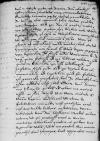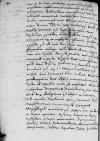Quantum ⌊Cracoviae⌋ pestis saeviat, procul dubio Reverendissima Dominatio Vestra ex aliis cognovit. Plus centum quottidie mori dicuntur. Sed ego, Deo sit gratia, mature me inde subduxi, septem fere diebus ante⌊ maiestatem regiam⌋, quae et ipsa in ⌊Niepolomice⌋ concesserat, ubi aula non fuit immunis a peste, nam et ostiarii, et cubicularii multi mortui sunt, ita ut vacua metu non fuerit
serenissima
maiestas regia, praecipue vero ⌊reginalis⌋. Ibi fuisse audio ⌊Mauricium⌋ Reverendissimae Dominationis Vestrae, quem habuisse ad me litteras arbitror, sed quoniam ⌊Columbae⌋ me esse intellexit, eo profectum fuisse puto. Sed ego viginti dies ibi commoratus, ad capitulum, quod hic habitum est, generale profectus sum. In Savichost cum essem, redditae mihi sunt litterae reverendissimi ⌊domini mei Plocensis⌋, quibus ad aulam me reverti iussit ac fore scripsit, ut in ⌊Nova Civitate⌋
serenissimam
⌊maiestatem regiam⌋ invenirem, ubi etiam de habitatione commoda mihi provisum erat. Etsi non valde lubens, constitueram tamen voluntati ⌊reverendissimi domini⌋ satisfacere. Accidit autem interea, ut qui praemissi erant in ⌊Novam Civitatem⌋ cubicularii quattuor, et quidem tres ⌊reginalis maiestatis⌋, subito morerentur. Quo nuntio perculsi ⌊serenissimi principes⌋, licet apparatus omnis iam in ⌊Novam Civitatem⌋ praemissus fuisset, consilium nihilo minus mutarunt et in rus proximum Dobrovodam concesserunt. Ubi dies aliquot commorati, tandem huc venerunt, et locum commorationis delegerunt in proximo rure domini thesaurarii ⌊Vieliviesz⌋. Quod etsi valde vicinum est loco huic, quia tamen ⌊Vistulam⌋ cotidie transmittere necesse est, non parva ex eo molestia afficimur, quibus ex oppido est ad rus tam saepe commeandum. Fugiebam aulam, aula venit ad me, fugere iam non licuit. Deo sit gratia, iam esse vide[tur] immunis a peste. Viginti dies intercesserunt, quod ⌊reverendissimo domino⌋ in Polianiecz famulus peste mortuus est, ex eo tempore auditum est nihil.
⌊Serenissimi principes⌋ bene valent. Quos hic quadraginta dies adhuc commoraturos puto. Inde ad ⌊comitia⌋ recta se conferent, quae ad Calendas Decembres ⌊Piiotrckoviae⌋ sunt edicta.
Serenissimus ⌊rex adolescens⌋ est adhuc in ⌊Lituania⌋. Ad ⌊comitia⌋ venturum ⌊eum⌋ speramus. Dominus archidiaconus Cracoviensis Georgius Mieschkowski mortuus est. Atque haec quidem in ⌊regno⌋ aguntur.
Ex vicino ⌊Hungariae regno⌋ tristissima quaeque nuntiantur. Expugnavit ⌊Soclosz⌋, ⌊Valpo⌋, Petervaradinum, ⌊Quinque Ecclesia[s]⌋, ⌊Strigonium⌋, ⌊Albam Regalem⌋, ⌊Tatam⌋, ⌊Palatam⌋. Profectus erat versus ⌊Cassoviam⌋ et iam sex millia passuum a ⌊Buda⌋ confecerat, cum mutato consilio ⌊Strigonium⌋ copias suas reduxit. Ubi ⌊regem Romanorum⌋ exspectare velle scribitur, cum eo proelium initurus. Deus Christianorum consilia secundet. Hac ipsa hora allatae sunt litterae, quibus scribunt iudex et iurati ⌊civitatis Bartphae⌋, quod miserit ⌊caesar⌋ ⌊Turcarum⌋ aliquot millia, qui explorarent, quantus esset ⌊regis Romanorum⌋ exercitus, qui omnes ab exercitu regio caesi sint. Dicitur habere ⌊rex Romanorum⌋ plus centum milia hominum. De ⌊rege Galliae⌋ allatum est exercitum eius omnem a caesarianis esse deletum. Confirma hoc, Deus, quod operatus es in nobis, ut post tot tristissimos nuntios laetior tandem aliquis veniat. Quem precor, ut Vestram quoque Reverendissimam Dominationem diu servet incolumem. Cuius me gratiae commendo.



